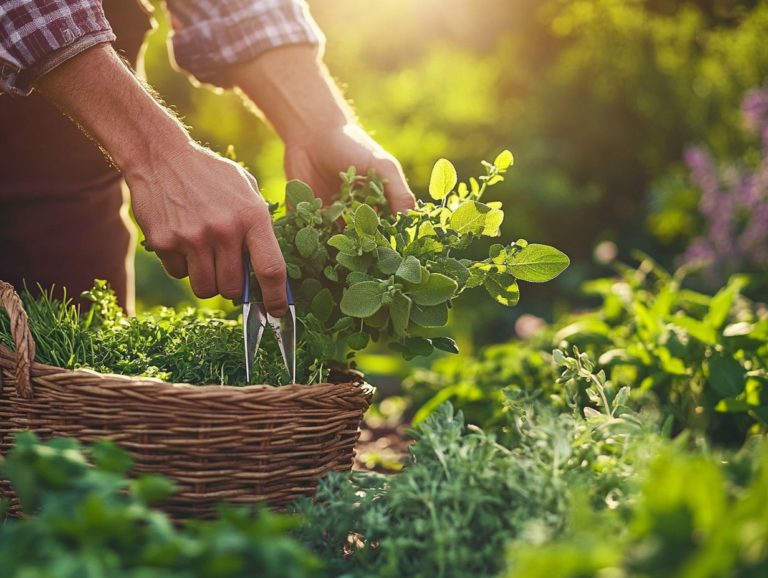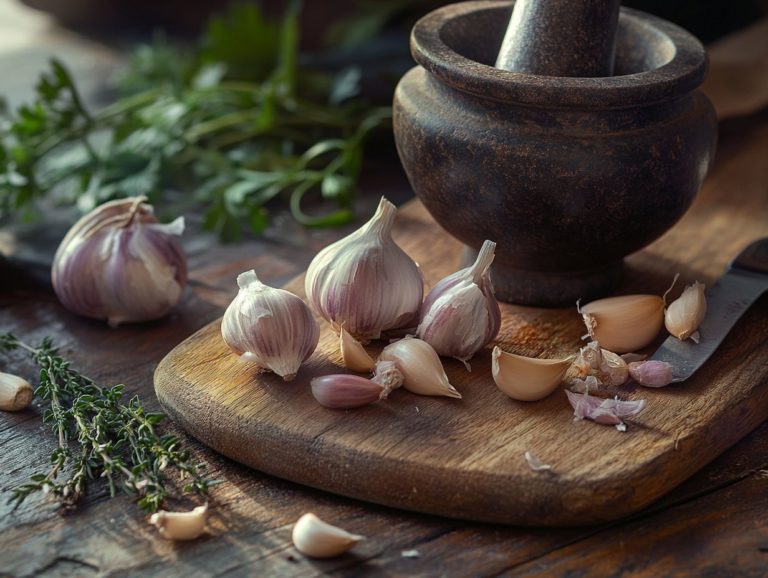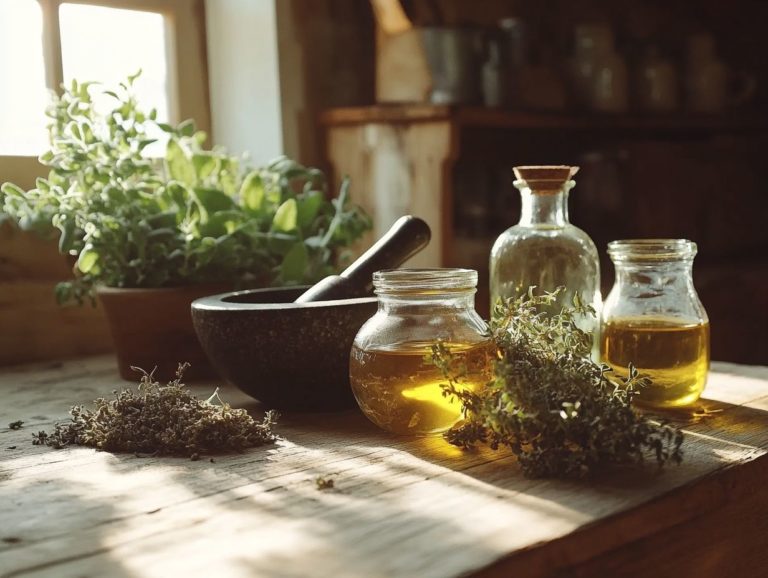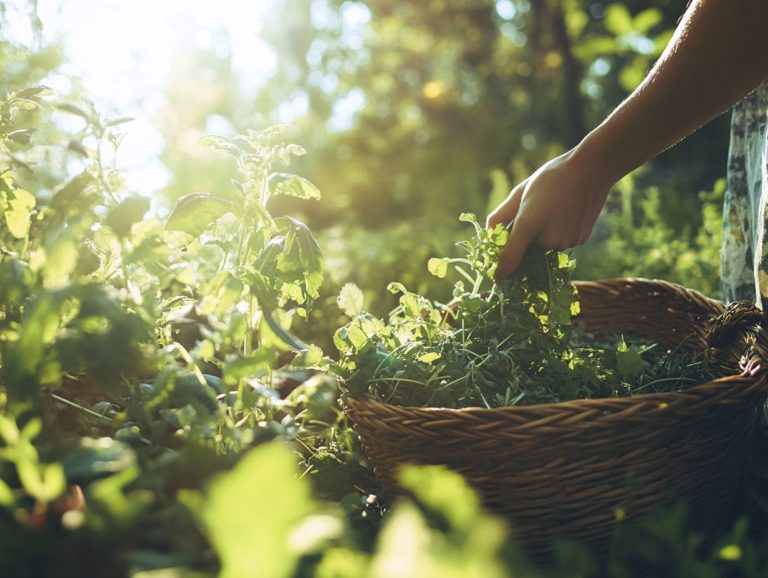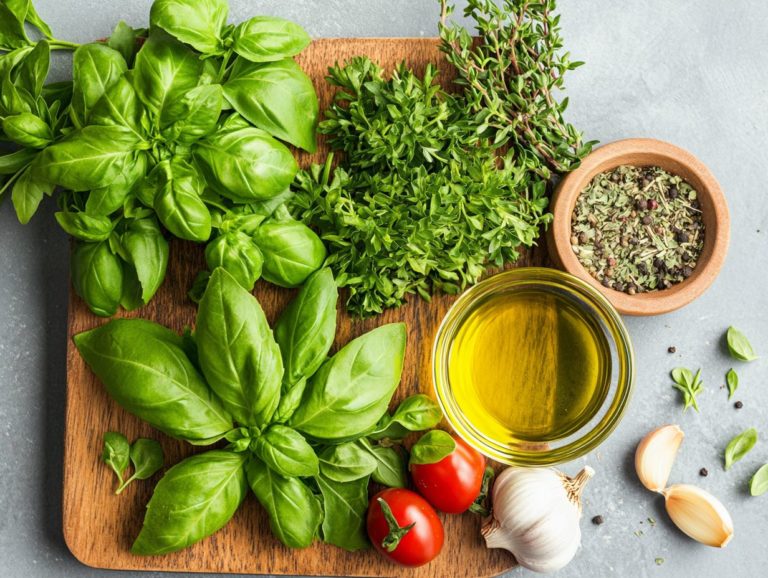How to Make Herbal Salves at Home
Discover the wonderful world of herbal salves! These natural remedies not only pamper your skin but also provide amazing healing benefits. This article delves into the essence of herbal salves, highlighting their myriad benefits and guiding you in selecting the most effective herbs for your needs. Get ready to unleash the power of nature and start your salve-making journey today!
Contents
Key Takeaways:
- Explore the world of herbal salves and their numerous benefits for your skin and health.
- Choose the right combination of herbs, understanding their properties to create the perfect salve for your needs.
- Create your own herbal salves at home by following a simple step-by-step guide using essential ingredients and equipment.
What are Herbal Salves?
Herbal salves are a collection of creams or ointments applied directly to the skin crafted from natural ingredients, meticulously designed to harness the healing properties of medicinal herbs. These soothing preparations often blend infused oils, beeswax pastilles, and essential oils, offering a versatile remedy for a range of skin ailments.
Whether you’re looking to relieve dry skin or support the healing of minor cuts with calendula salve or St. John s wort, herbal salves embody a holistic approach to health and wellness. As more individuals embrace a natural lifestyle, the popularity of homemade salves has surged, giving you the power to create customized solutions tailored precisely to your specific needs.
Definition and Benefits
Herbal salves are concentrated blends of herbal extracts, oils that help carry the benefits of herbs into your skin, and waxes that offer a wealth of healing benefits for your skin health.
These salves often feature a delightful array of natural ingredients, like nourishing carrier oils such as coconut or olive oil. Not only do these oils serve as a luxurious base, but they also deliver essential fatty acids that deeply moisturize your skin. Add some beeswax pastilles into the mix, and you ve got a protective barrier that locks in moisture while shielding your skin from environmental irritants.
The combined effect of these components works wonders, soothing conditions like dry skin, minor cuts, and even minor burns. It s all about harnessing the natural power of herbs to promote healing, providing a gentle yet effective solution suitable for various skin types.
Choosing the Right Herbs for Your Salve
Selecting the right herbs is essential when crafting a herbal salve, as each medicinal herb offers unique properties that enhance the salve’s effectiveness and targeted healing benefits.
For instance, plantain leaves are well-known for their anti-inflammatory properties, while comfrey leaves excel in promoting skin regeneration. Herbs like lavender and calendula are celebrated for their soothing effects, making them perfect choices for anyone dealing with dry skin or minor cuts.
By grasping the specific benefits of each herb, you can create a customized herbal oil infusion tailored to your needs.
Understanding Herbal Properties
Understanding the specific healing properties of medicinal herbs is essential for you if you’re aiming to create effective herbal salves tailored to your unique needs.
These plants are cherished for promoting healing, reducing inflammation, and soothing skin irritations. When you harness the healing qualities of these herbs correctly, they can unlock a treasure trove of benefits.
Take yarrow, for example it’s renowned for its capacity to accelerate wound healing and boasts impressive antiseptic properties, making it invaluable for treating cuts and scrapes. Then there’s St. John’s wort, celebrated for its prowess in alleviating nerve pain and bruises, particularly effective in topical applications.
Combining these herbal ingredients not only enhances the effectiveness of your salves but also offers a natural, holistic approach to skincare.
Supplies and Tools Needed
Crafting your own herbal salves involves gathering a few essential supplies and tools that not only streamline the process but also elevate the quality of your homemade remedy.
A double boiler is critical for gently melting beeswax and oils. A carrier oil is a base oil used to dilute essential oils, making them safe for skin application. High-quality carrier oils such as olive oil or coconut oil provide the perfect base for infusing your chosen herbs. By adding essential oils, you can enhance the salve’s properties, making it a soothing and effective topical treatment.
With these tools at your disposal, you’ll feel empowered to embark on your DIY salve-making journey with confidence.
Essential Ingredients and Equipment
The essential ingredients for crafting a successful herbal salve include a carrier oil, beeswax pastilles, and a selection of beneficial essential oils all working together to create a potent blend for your skin.
The carrier oil acts as the foundation for your salve. Popular options include olive oil, sweet almond oil, and jojoba oil, each chosen for its unique benefits. Beeswax pastilles bring natural thickness to your salve, solidifying the mixture and forming a protective barrier that locks in moisture.
Essential oils elevate the salve’s aroma while introducing therapeutic benefits. For calming properties, consider lavender; for antibacterial effects, try tea tree oil. Sourcing these oils from reputable suppliers who specialize in organic and sustainably harvested products ensures both quality and effectiveness in your final blend.
Step-by-Step Guide to Making Herbal Salves
Making your own herbal salve is an exciting adventure! Unlock the healing powers of nature with this simple DIY process. You ll begin with a step-by-step guide that starts with crafting a herbal oil infusion this is the foundation of any effective salve.
Once your infusion is ready, you ll blend it with beeswax and essential oils, ensuring that the final product not only serves its purpose but also delights your senses with its fragrance.
Always conduct a patch test before applying it widely to guarantee the salve s compatibility with your skin type.
Instructions and Tips for Beginners
As you embark on your journey into the world of DIY herbal salve making, following straightforward instructions while keeping a few key tips in mind can elevate your experience and results.
Understanding the healing properties of various herbs, like chamomile or calendula, will significantly enhance the effectiveness of your salves. Be mindful to avoid common pitfalls, such as failing to properly dry your herbs or selecting unsuitable carrier oils, as these mistakes can lead to disappointing outcomes.
For the best results, always do a patch test before using a new salve. This step helps you avoid skin reactions to unfamiliar ingredients.
As a budding herbalist, it s also beneficial to familiarize yourself with different salve-making techniques, like cold infusion or the double boiler method. This knowledge will ensure you expertly extract the healing qualities of each herb, creating salves that are both effective and delightful to use.
Uses and Applications of Herbal Salves
Herbal salves offer an impressive range of uses and applications, acting as potent topical treatments that enhance skin health and overall wellness.
Use calendula salve for minor cuts. Try bug balm for insect bites. These products are must-haves for your herbal remedy toolkit.
By incorporating healing herbs like lemon balm and manuka honey, you create salves that not only soothe the skin but also bolster your well-being with their natural ingredients. The versatility of herbal salves truly makes them an invaluable addition to your skincare routine.
Topical and Medicinal Benefits
The topical and medicinal benefits of herbal salves come from the healing properties of the carefully selected herbs, providing you with a natural remedy for various skin issues.
By tapping into the power of nature, these salves can work wonders! They soothe your dry, chapped skin while delivering essential hydration and nourishment. Take calendula, for example; its anti-inflammatory properties can help you heal minor cuts and bruises more quickly.
Similarly, tea tree oil has impressive anti-bacterial qualities, making it a fantastic choice for combatting acne-prone skin. And let’s not forget chamomile, which provides gentle, calming relief for irritation and redness.
These amazing natural solutions can repair your skin and boost your wellness, making herbal salves an invaluable part of your skincare routine!
Storing and Preserving Your Salves
Properly storing and preserving your herbal salves is crucial for maintaining their strength and how well they work over time. This ensures you can benefit from their healing properties whenever you need them.
The best storage conditions involve placing the salves in a cool, dark environment, away from direct sunlight and heat, both of which can significantly shorten their shelf life.
By selecting suitable containers and mastering the best preservation techniques, you can extend the usability of your homemade salves, ensuring they remain a dependable ally in your skincare routine.
Proper Storage Techniques
To ensure the longevity and effectiveness of your herbal salves, it s essential to employ proper storage techniques. This goes beyond simply selecting a suitable container; the materials you choose and the environment in which you store them are crucial!
Opting for dark glass containers can notably shield your salves from harmful UV rays that can degrade the active ingredients over time. Keep these remedies in cool, dry areas, away from direct sunlight, which will help preserve their strength.
Such practices not only prolong the shelf life of your herbal salves but also enhance how well they work, ensuring you receive the maximum benefits upon application! Thoughtful preservation methods are key to maintaining the integrity of these natural products.
Frequently Asked Questions
What are herbal salves?
Herbal salves are a delightful combination of herbs and oils that are used for their medicinal and healing properties. They re typically applied topically to the skin. Explore the world of herbal salves!
Why make herbal salves at home?
Making herbal salves at home allows you to customize the ingredients to suit your specific needs and preferences. It also ensures that you are using high-quality, natural ingredients. Give it a try!
What supplies do I need to make herbal salves at home?
You will need a combination of herbs, carrier oils, beeswax, and essential oils. You will also need containers for storing the salve, such as glass jars or tins. Gather your materials and get started!
How do I choose the right herbs for my herbal salve?
Choosing herbs with specific healing properties is important. Research the medicinal properties of different herbs and select a combination that addresses your needs. Unlock the potential of nature!
What is the process for making herbal salves at home?
Curious about how to create your own herbal salves at home? The process is simple! It involves infusing the herbs in oil, straining out the herbs, and then adding beeswax and essential oils to create a solid salve. For more detailed instructions, you can check out this guide on how to make a herbal tincture at home, as many tutorials are available online.
How do I store and use my herbal salve?
Store your herbal salve in a cool, dry place away from direct sunlight. To use, simply apply a small amount to the desired area and massage it in gently. Consult a healthcare professional if you have any concerns about allergies or interactions with medications. Enjoy the benefits!
Ready to enhance your skincare routine with herbal salves? Try making your own today!

